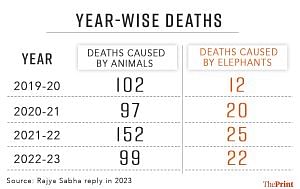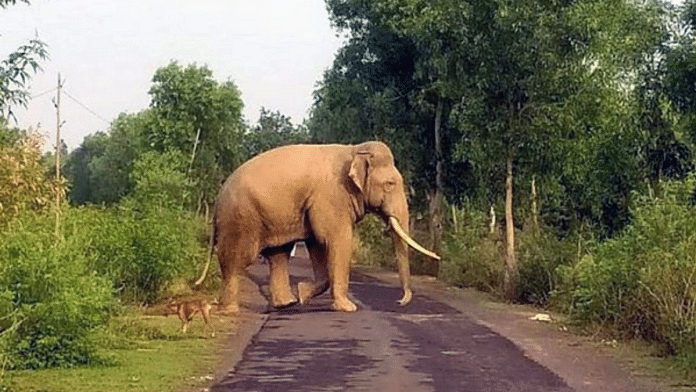New Delhi: A 20-year-old elephant, Belur Makhna, which trampled a man to death on 10 February in Wayanad’s Mananthavady municipality, has so far eluded a 200-strong team of forest guards, range officers and veterinarians, and four trained elephants. The forest team last spotted Belur Makhna near Wayanad’s Irumbupalam village on Saturday night.
With the animal still on the loose, residents remain restive and have been staging protests all week amid increasing human-animal conflict in the region. Belur Makhna’s case is one in a string of incidents — six people in the state have been killed by elephants in the past one-and-a-half months. In the latest case from 16 February, a herd of elephants attacked and left a forest guide dead in Kuruva in South Wayanad.
The forest team wants to rehabilitate Belur Makhna in the Muthanga Elephant Camp in east Wayanad.
“It is a problem animal and has raided crops before. If we leave it to the wild, it’ll just come back to farms. We want to bring it back to Muthanga and rehabilitate it,” Kerala’s chief wildlife warden, D. Jayaprasad, told ThePrint.
A total of 24 forest guards from neighbouring Karnataka, from where the elephant crossed the border into Kerala, have also joined the search.
Residents whose lives and livelihoods are at risk are unhappy with the rising incidents of conflict. Jithin Komath, a 35-year-old resident of Wayanad’s Thirunelly who is participating in the protests after the killing of the forest guide in Kuruva, said these are not isolated incidents.
“We’ve been protesting human-wildlife conflict for years in villages. Now that the attacks are happening near towns like Mananthavady, people are noticing it more,” he said.
“Wild boars are one example of animals raiding our crops. What about elephants and tigers? They kill us and destroy our crops, but we can’t act against them at all,” he asked.
Also read: Rahul Gandhi visits Wayanad; meets families of elephant attacks victims
Wayanad’s elephant problem
Belur Makhna crossed into Wayanad from bordering Karnataka on 5 January, said forest officials. On 10 February, it entered Palvelicham village, chased a man down and struck him on the head, killing him instantly.
North Wayanad divisional forest officer Martin Lowell said Belur Makhna ran 5 km in the forests from Palvelicham village, and the team has been tracking the animal ever since. At Muthanga camp, the team would be able to rehabilitate the elephant and keep it away from agricultural fields and human settlements.
Currently, there are eight elephants at the camp. Four of them are kumkis — elephants that are trained by the forest department and help it carry out work such as capturing other rogue animals.
“Sometimes, we use kumki elephants to scare animals that have strayed out of the forest and make them go back in. But, because kumkis are trained wild elephants, they also help us handle a problem elephant and capture it without causing harm,” said Lowell.
All four kumki elephants are engaged in the search for Belur Makhna, which also has a malfunctioning radio collar. According to Lowell, they get radio signals every one to four hours, but most of the time, the animal leaves by the time the team reaches the location. On Saturday evening, the team found Belur Makhna at Irumbupalam.
“When we tried to get closer, it charged at us and nearly injured one of the vets. Everyone, thankfully, escaped, but it tells you that this is not an easy elephant to catch,” said Lowell.
Nishant Srinivasiah, a behavioural ecologist who specialises in Asian elephants’ behaviour in human-dominated landscapes in the Eastern Ghats, stressed the need for more inclusive development plans.
“The rapidly changing land use patterns in elephant habitats, and the way elephants adapt to it behaviourally, can result in actions that aren’t always compatible with human or elephant needs,” he said.
Human-wildlife conflict in Kerala

Last year, there were a total of 99 deaths due to animal attacks in the state, 22 due to elephants. Additionally, there were nearly 4,500 instances of cattle, crop, or property loss because of animal attacks in 2023, according to a Rajya Sabha reply in December 2023.
This comes in the backdrop of the Kerala state assembly passing a unanimous resolution on 14 February, asking the central government to amend the Wildlife Protection Act, 1972, to make it easier to manage human-animal conflict. In its resolution, the state requested the Centre to declare wild boars as ‘vermin’ animals under Schedule V of the Act. These ‘vermin’ animals like fruit bats or rats are not granted protection from hunting.
The resolution also wants to ease the procedure of dealing with animal attacks, asking for the grant of power to take immediate action to the different chief conservators of forests instead of to the chief wildlife warden only. The residents of areas such as Mananthavady and Pulpally, who are demanding stronger action against animal attacks, strongly supported the resolution.
Also read: Kerala Assembly passes resolution urging Centre to amend wildlife laws as animal attacks rise
What can be done about it?
Kerala has seen infamous wild elephant attacks earlier, too. An elephant by the name of Arrikomban, who would break into ration shops to steal rice, eventually killed seven people. He was finally captured and released into an undisclosed location in April 2023 on the orders of the Kerala High Court.
Nearly 30 percent of Kerala’s entire geographical region is covered in forests, which include 16 wildlife sanctuaries, six national parks, and two tiger reserves. Most of the human-wildlife conflicts, according to the forest department, occur in the fringes or buffer areas of these protected forests of the state.
Wayanad’s forests are part of the Brahmagiri–Nilgiri–Eastern Ghats Elephant Landscape (NEG), home to the largest contiguous population of Asian elephants globally, according to a 2020 study published in the Current Science journal. However, the paper warned against the increasing ‘degradation’ of the forest, its conversion into an agricultural landscape, and the loss of biodiversity spots like swamps and bamboo clumps in Wayanad. The study attributed increasing human-elephant conflict in the region to this forest degradation, among other things.
According to Srinivasiah, as long as development goals remain human-centric, conflicts between humans and elephants will occur. “We need to take into account non-humans such as elephants and other animals and their ecological, biological, and social needs when we alter landscapes for our own use and advantage,” said Srinivasiah.
(Edited by Madhurita Goswami)
Also read: Wayanad elephant attack: Kerala govt announces Rs ten lakh compensation to man’s family



